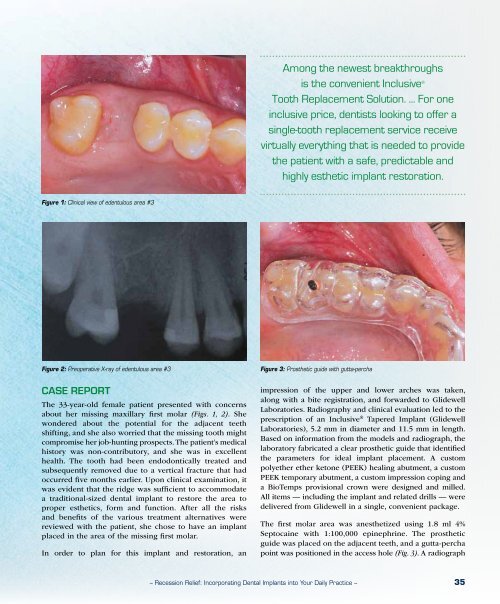PDF Download - Glidewell Dental Labs
PDF Download - Glidewell Dental Labs
PDF Download - Glidewell Dental Labs
You also want an ePaper? Increase the reach of your titles
YUMPU automatically turns print PDFs into web optimized ePapers that Google loves.
Among the newest breakthroughs<br />
is the convenient Inclusive ®<br />
Tooth Replacement Solution. ... For one<br />
inclusive price, dentists looking to offer a<br />
single-tooth replacement service receive<br />
virtually everything that is needed to provide<br />
the patient with a safe, predictable and<br />
highly esthetic implant restoration.<br />
Figure 1: Clinical view of edentulous area #3<br />
Figure 2: Preoperative X-ray of edentulous area #3<br />
Case Report<br />
The 33-year-old female patient presented with concerns<br />
about her missing maxillary first molar (Figs. 1, 2). She<br />
wondered about the potential for the adjacent teeth<br />
shifting, and she also worried that the missing tooth might<br />
compromise her job-hunting prospects. The patient’s medical<br />
history was non-contributory, and she was in excellent<br />
health. The tooth had been endodontically treated and<br />
subsequently removed due to a vertical fracture that had<br />
occurred five months earlier. Upon clinical examination, it<br />
was evident that the ridge was sufficient to accommodate<br />
a traditional-sized dental implant to restore the area to<br />
proper esthetics, form and function. After all the risks<br />
and benefits of the various treatment alternatives were<br />
reviewed with the patient, she chose to have an implant<br />
placed in the area of the missing first molar.<br />
In order to plan for this implant and restoration, an<br />
Figure 3: Prosthetic guide with gutta-percha<br />
impression of the upper and lower arches was taken,<br />
along with a bite registration, and forwarded to <strong>Glidewell</strong><br />
Laboratories. Radiography and clinical evaluation led to the<br />
prescription of an Inclusive ® Tapered Implant (<strong>Glidewell</strong><br />
Laboratories), 5.2 mm in diameter and 11.5 mm in length.<br />
Based on information from the models and radiograph, the<br />
laboratory fabricated a clear prosthetic guide that identified<br />
the parameters for ideal implant placement. A custom<br />
polyether ether ketone (PEEK) healing abutment, a custom<br />
PEEK temporary abutment, a custom impression coping and<br />
a BioTemps provisional crown were designed and milled.<br />
All items — including the implant and related drills — were<br />
delivered from <strong>Glidewell</strong> in a single, convenient package.<br />
The first molar area was anesthetized using 1.8 ml 4%<br />
Septocaine with 1:100,000 epinephrine. The prosthetic<br />
guide was placed on the adjacent teeth, and a gutta-percha<br />
point was positioned in the access hole (Fig. 3). A radiograph<br />
– Recession Relief: Incorporating <strong>Dental</strong> Implants into Your Daily Practice – 35
















